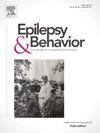Evaluating the Status Epilepticus in Pediatric patients Severity Score (STEPSS): A systematic review and meta-analysis
IF 2.3
3区 医学
Q2 BEHAVIORAL SCIENCES
引用次数: 0
Abstract
Objective
The Status Epilepticus in Pediatric patients Severity Score (STEPSS) has been utilized to assess outcomes in children with status epilepticus (SE). This study aims to evaluate STEPSS’s diagnostic efficacy in predicting survival outcomes for SE patients.
Methods
A meta-analysis was conducted to address this objective, calculating pooled sensitivity, specificity, positive likelihood ratio (PLR), negative likelihood ratio (NLR), diagnostic odds ratio (DOR), area under the curve (AUC), Relative Risk (RR) and corresponding 95 % confidence intervals (95 % CI). Subgroup analysis, meta-regression analysis and the Deek’s plot were used to evaluate heterogeneity.
Results
Eight article met inclusion criteria. The literature exhibited non-threshold effect-caused heterogeneity. Pooled sensitivity and specificity, using a random-effects model, were 0.82 (95 % CI: 0.71, 0.90) and 0.78 (95 % CI: 0.70, 0.85), respectively. DOR was 18 (95 % CI: 8, 43), and the Summary Receiver Operating Characteristic AUC (SROC-AUC) was 0.85. Pooled RR showed that the accuracy of using STEPSS for SE diagnosis was 10.74 times higher than without using it (RR = 10.74, 95 % CI: 6.12, 18.86).
Conclusion
STEPSS demonstrates strong predictive efficacy for pediatric SE, supporting its diagnostic use in children.
Significance
These findings moderately validate STEPSS’s utility in predicting outcomes in pediatric SE.
评估儿童癫痫持续状态患者严重程度评分(STEPSS):一项系统回顾和荟萃分析
目的应用儿童癫痫持续状态严重程度评分(STEPSS)评估儿童癫痫持续状态(SE)的预后。本研究旨在评估STEPSS在预测SE患者生存结局方面的诊断效果。方法采用meta分析,计算合并敏感性、特异性、阳性似然比(PLR)、阴性似然比(NLR)、诊断优势比(DOR)、曲线下面积(AUC)、相对危险度(RR)及相应的95%置信区间(95% CI)。采用亚组分析、meta回归分析和Deek’s图评价异质性。结果8篇文章符合纳入标准。文献显示非阈值效应引起的异质性。采用随机效应模型,合并敏感性和特异性分别为0.82 (95% CI: 0.71, 0.90)和0.78 (95% CI: 0.70, 0.85)。DOR为18 (95% CI: 8,43),总受试者工作特征AUC (SROC-AUC)为0.85。合并RR显示,使用STEPSS诊断SE的准确率是未使用STEPSS的10.74倍(RR = 10.74, 95% CI: 6.12, 18.86)。结论stepss对儿童SE具有较强的预测效果,支持其在儿童中的诊断应用。这些发现适度验证了STEPSS在预测儿童SE预后方面的实用性。
本文章由计算机程序翻译,如有差异,请以英文原文为准。
求助全文
约1分钟内获得全文
求助全文
来源期刊

Epilepsy & Behavior
医学-行为科学
CiteScore
5.40
自引率
15.40%
发文量
385
审稿时长
43 days
期刊介绍:
Epilepsy & Behavior is the fastest-growing international journal uniquely devoted to the rapid dissemination of the most current information available on the behavioral aspects of seizures and epilepsy.
Epilepsy & Behavior presents original peer-reviewed articles based on laboratory and clinical research. Topics are drawn from a variety of fields, including clinical neurology, neurosurgery, neuropsychiatry, neuropsychology, neurophysiology, neuropharmacology, and neuroimaging.
From September 2012 Epilepsy & Behavior stopped accepting Case Reports for publication in the journal. From this date authors who submit to Epilepsy & Behavior will be offered a transfer or asked to resubmit their Case Reports to its new sister journal, Epilepsy & Behavior Case Reports.
 求助内容:
求助内容: 应助结果提醒方式:
应助结果提醒方式:


